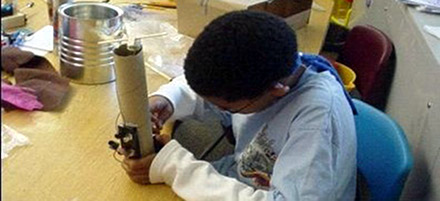
Wk 4: Creating an Informative Poster / PowerPoint

Learning Outcomes:
- The learner will plan / organize a layout for a poster / PowerPoint.
- The learner will compose and list information pertaining to his/her invention.
- The learner will apply details of spacing, margins, colors, and layout to maximize poster or PowerPoint effectiveness.
Standards:
- Fourth Grade, English Language Arts, Goal 4, Objective 4.03
- Fourth Grade, English Language Arts, Goal 4, Objective 4.07
Assessment:
- When posters are completed and prior to the official Invention Convention, the teacher will assign student pairs and will distribute a “Peer Poster Rubric.” The less familiar the pairs are with student’s actual invention, the more objective the student opinions and evaluations will be.
- The “Peer Poster Rubric” can be found in the “Teacher Created Resources” column on the “Invention Convention” lessons page.
- Each student will use the rubric and their partner’s poster to evaluate the effectiveness of the poster. The teacher should remind the student NOT to ask the partner for additional information, but to rely only on the poster.
Introduction:
“Invention Convention” is an integrated project combining learning from language arts, science, and math curriculums allowing students to apply their understandings of magnets and electricity by designing or improving an existing invention.
Classroom Time Required:
- Multiple, forty five minute sessions, depending on student and teacher expectations
Materials Need:
- Poster board, 1 / student
- Consumable supplies including: construction paper, permanent markers, colored pencils
- Rulers
- Computers (if creating a power point)
- Peer Poster Rubric, 1 / student (conclusion of poster making)
Pre-activities:
- Prior to this lesson, students should have completed “Designing the Invention” and “Naming the Invention.”
Activities:
- Although most students have previously created a poster, the purpose of this lesson is to help students identify components of effective posters and Power Points that make information easily identified and understood while being aesthetically pleasing. The lesson is specifically designed for posters, but the skills can be utilized in creating Power Points, as well.
Part 1
- The teacher will acquire and display several different posters from various sources. Some examples may include: movie posters, community events, church dinners, advertisements, campaign signs, billboard pictures, full page newspaper ads.
- As a class, students will brainstorm the purpose of posters. Some responses may include: to get people’s attention, to get people to do something, to give people information, etc.
- Working in partners, the students will compare and contrast the array of posters. The teacher will guide the students to look beyond the what will initially “stand out” to the students, and to notice components such as
-
- Number of colors used (usually, no more than three)
- Size of the font (large and easily read from a distance)
- The presence of margins (consistent amount all the way around)
- How writing is conveyed using brief amounts of information with bullets
- Use of graphics / pictures (very few, usually one)
- When time is up the students can share their observations, which will hopefully include the attributes listed above.
- For each attribute, the students should explain why those are effective. For example, using fewer colors makes the writing stand out and more obvious to readers. Have a large font size makes the wording easier to read. Having margins makes the poster appear neat and makes it seem easier to “take in” all the information. Bulleted, brief phrases tell readers just enough information to get them more interested. One graphic allows the reader to concentrate on one, most important, image.
- The teacher will bring the discussion to a close by making this information relevant to the students’ Invention Convention. The student’s posters should
-
- Attract people’s attention at the Invention Convention
- Give people basic information about their invention such as:
-
- What is this?
- Who created it?
- Why is it important?
- Possibly, how does it work?
- Make people want to know more about their invention
- Adhere to attributes that make posters effective
Part 2
- Following the introductory lesson to posters, students will create posters of their own. If time allows, teachers may want students to create a poster plan on a blank, white sheet of paper. The students can block out general spaces for where the will put information and graphics so they will have a plan to work from when using their poster board.
- The teacher should remind students that these posters will be used to attract people to view their invention up close at the Invention Convention.
- Students should be reminded to adhere to the Poster Attributes so they will have effective posters to display at Invention Convention.

